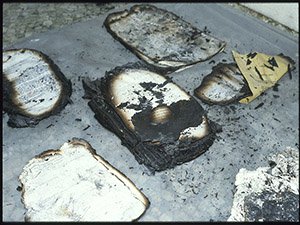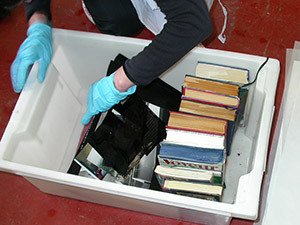Protecting our Archive
 Surrey History Centre has been carefully designed to protect our county's archive. We have three purpose-built, robust and secure strongrooms. Environmental conditions are carefully controlled and monitored. Humidity and temperatures levels are kept well within national archive standards. We ensure our collections are protected from pests that eat paper and books such as silverfish, carpet beetles and moths. Our staff are trained to handle fragile material with care, and items are packaged carefully in protective archival paper and boxes.
Surrey History Centre has been carefully designed to protect our county's archive. We have three purpose-built, robust and secure strongrooms. Environmental conditions are carefully controlled and monitored. Humidity and temperatures levels are kept well within national archive standards. We ensure our collections are protected from pests that eat paper and books such as silverfish, carpet beetles and moths. Our staff are trained to handle fragile material with care, and items are packaged carefully in protective archival paper and boxes.
We have a fire suppressant system which would quickly extinguish any fire within the strong rooms by reducing oxygen levels. In short, we do everything we can to ensure our archive material is well cared for and protected.
Be prepared!
 As well as prevention, we must also be prepared for any unexpected incidents that could impact our archive contents. Surrey History Centre has a detailed 'Disaster Plan' to ensure we can react quickly to save material that may become damaged. We also have a team of trained Salvage Response Co-ordinators to help our Conservator rescue any damaged material.
As well as prevention, we must also be prepared for any unexpected incidents that could impact our archive contents. Surrey History Centre has a detailed 'Disaster Plan' to ensure we can react quickly to save material that may become damaged. We also have a team of trained Salvage Response Co-ordinators to help our Conservator rescue any damaged material.
We have response plans for both minor and major incidents:
- A minor incident may involve material becoming damaged outside the strongrooms, for example, in the research room potentially through a leak, broken window or vandalism.
- A major incident would involve damage to the archive building structure, such as a serious storm, a fire, flood, accident or terrorist attack.
Types of damage
 Archive material can become damaged in several ways. Fire can cause irreversible damage. Water is often the biggest problem as this can cause severe damage to archival materials and can also result in mould growth if items are not treated within 72 hours.
Archive material can become damaged in several ways. Fire can cause irreversible damage. Water is often the biggest problem as this can cause severe damage to archival materials and can also result in mould growth if items are not treated within 72 hours.
Damage caused by water includes:
- Paper items becoming very fragile and easily damaged
- Staining and contamination from dirty water
- Coated papers sticking together
- Water sensitive dyes and inks bleeding and transferring to other material
- Books expanding, distorting and damaging covers
- Parchment becoming glutinous and then becoming brittle and distorted when dry
Salvaging archive material
 So, what steps do we take to salvage damaged archives? After ensuring an area is safe to enter, we'd need to mitigate further damage by protecting undamaged material and removing standing water. Damaged material then needs to be safely transferred to recovery areas where material can be assessed and treated. This work is done in order of priority and items at greatest risk, as agreed with the management team.
So, what steps do we take to salvage damaged archives? After ensuring an area is safe to enter, we'd need to mitigate further damage by protecting undamaged material and removing standing water. Damaged material then needs to be safely transferred to recovery areas where material can be assessed and treated. This work is done in order of priority and items at greatest risk, as agreed with the management team.
The transfer of damaged material requires trained staff. Items can become even more damaged if they are not removed carefully from shelving with adequate support and careful handling.
If an incident is small enough to manage in-house, items are transported to the response area to be removed from any wet and dirty packaging, air dried and assessed for any further treatment by the Conservator. It is important that all moved material is tracked, labelled and kept in order, so a methodical, organised response is essential to prevent loss and misplaced items.
 In the event of a major incident where large amounts of archival material become damaged or need to be moved off-site, we would need to call on an external company to provide specialist support and transportation to a larger salvage facility. In this case the focus would be on safely packing, listing and labelling material that can be frozen in crates to allow controlled drying at a future date. Not all material can be frozen, so items need to be carefully sorted and treated appropriately.
In the event of a major incident where large amounts of archival material become damaged or need to be moved off-site, we would need to call on an external company to provide specialist support and transportation to a larger salvage facility. In this case the focus would be on safely packing, listing and labelling material that can be frozen in crates to allow controlled drying at a future date. Not all material can be frozen, so items need to be carefully sorted and treated appropriately.
Our archive building is very secure, and a major incident is unlikely. However, if the worst were to happen, we have a plan in place, with trained staff equipped to respond in a way that would help us rescue material in the most efficient way possible.
Images
Select image to view a larger version.
- One of the strongrooms at Surrey History Centre
- Records of the Epsom Cluster hospitals found in a basement
- Fire-damaged material
- Water-damaged parchment
- Items being crated for freezing

